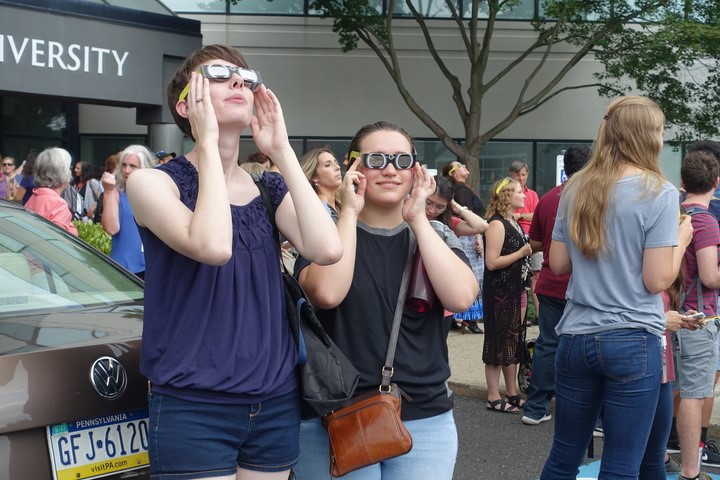 If you’re going to observe the upcoming solar eclipse on Monday, April 8, Pennsylvania College of Optometry (PCO) at Salus University faculty members urge you to do so safely, with the proper protective glasses.
If you’re going to observe the upcoming solar eclipse on Monday, April 8, Pennsylvania College of Optometry (PCO) at Salus University faculty members urge you to do so safely, with the proper protective glasses.
According to Bisant Labib, OD ‘14, Resident ‘15, FAAO, Dipl., CEC, PCO/Salus associate dean of Optometric Special Programs, internship coordinator and co-chief of Suite 3 Primary Care Services at The Eye Institute (TEI), people normally have innate mechanisms that prevent us from focusing on the harmful rays of the sun, such as squinting, blinking and closing your eyes. With the coverage from the eclipse and diminished brightness upon viewing, those natural reflexes are not as strong.
“As a result, you may be more readily able to stare at harmful light for a prolonged period of time and risk damage to sensitive ocular tissue in the back of your eye,” said Dr. Labib. “Using the right protection, such as eclipse glasses, which filter out those harmful solar rays, would prevent that from occurring. It is also important to ensure your eclipse glasses are intact without scratches or damage.”
The Philadelphia region will experience a partial solar eclipse reaching more than 90 percent totality. The event — where the path of the moon crosses in front of the sun — will cover nine-tenths of the sun’s surface locally. That makes this a “deep partial” solar eclipse, where the sky will get noticeably darker, brighter stars will be visible and the sun’s profile will be reduced to a slender crescent. Note that viewing success is dependent on weather and cloud cover.
The moon will begin its path across the sun at 2:08 p.m. and will move from south to west for nearly two-and-a-half hours, until 4:35 p.m. in the Philadelphia region. The highest coverage will occur at 3:23 p.m. This is the greatest solo coverage the region has seen since Memorial Day weekend in 1984.
Safe viewing methods include:
According to Maria Armandi, OD ‘92, Resident ‘93, assistant professor and laboratory coordinator Optics 1 and 2 in the first-year Doctor of Optometry curriculum, the eclipse brings together many optical principles.
“Eclipse glasses are not made with a dye or tint. They are created by placing fine carbon particles (think black and dense) in between layers of a special type of polyester Mylar with an outer layer of aluminum to add even more protection by reflecting off more visible light,” said Dr. Armandi. “This combination of materials absorbs 1,000 times more light than even the darkest sunglasses. Therefore, only a fraction of a percent of visible light is transmitted, .00032 percent to be exact.”
According to Dr. Armandi, when you think about that infinitesimally small amount of light and realize you can see that light as bright as the sun even through the eclipse glasses, it further illustrates the strength of sunlight.
"So, it’s very important for everyone to understand that tinted sunglasses, even with UV absorptive filters, are not safe for viewing the sun even during an eclipse,” she said. “Grab some eclipse glasses, download an eclipse app such as the Great American Eclipse or Solar Snap, and enjoy the amazing show on Monday.”